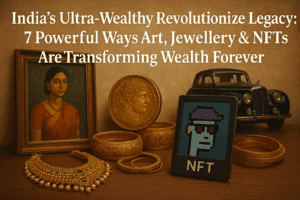India’s Ultra-Wealthy Revolutionize Legacy: 7 Powerful Ways Art, Jewellery & NFTs Are Transforming Wealth Forever
India’s ultra-high-net-worth individuals (UHNIs) are redefining luxury by prioritizing emotionally resonant, culturally significant assets over fleeting indulgences. According to Kotak Private’s 2024 report, 94% own jewellery—not just as adornment but as intergenerational heirlooms—while 73% invest in modern Indian art, blending aesthetic pride with financial foresight (evidenced by record-breaking sales like Amrita Sher-Gil’s ₹61.8 crore painting). A surprising 33% hold NFTs, embracing blockchain’s potential for digital scarcity and global relevance. Traditional status symbols like designer handbags are fading, replaced by vintage cars, rare coins, and artifacts that merge nostalgia with value retention.
This pivot reflects a strategic fusion of heritage preservation and avant-garde diversification, where assets serve dual roles: safeguarding cultural identity and ensuring long-term wealth growth. As India’s economy evolves, UHNIs are crafting legacies that transcend materialism, anchoring their wealth in stories, history, and innovation. The trend underscores a global shift where affluence is measured not just by possession, but by purpose.

India’s Ultra-Wealthy Revolutionize Legacy: 7 Powerful Ways Art, Jewellery & NFTs Are Transforming Wealth Forever
A profound shift is underway among India’s ultra-high-net-worth individuals (UHNIs). No longer content with conventional symbols of wealth—luxury cars, sprawling estates, or designer wardrobes—the country’s elite are increasingly channeling their resources into assets that blend emotional resonance, cultural heritage, and strategic value. From rare art and heirloom jewellery to cutting-edge NFTs, these investments reflect a deeper desire to curate legacies that transcend mere financial worth.
The Emotional Portfolio: Why Passion Meets Pragmatism
The Kotak Private Top of the Pyramid 2024 report reveals that 94% of India’s ultra-wealthy own fine jewellery, 73% invest in collectible art, and 33% hold NFTs. This pivot underscores a nuanced approach to wealth management, where assets are chosen not only for their appreciation potential but for their ability to embody identity, history, and cultural pride.
Jewellery: More Than Gold
Jewellery reigns supreme, with 79% of UHNIs planning to expand their collections. In India, gold has long been a safe haven, but today’s collectors seek pieces that double as heirlooms—intricate designs that narrate family histories or celebrate regional craftsmanship. “Jewellery is a bridge between generations,” notes a Mumbai-based heritage jeweler. “Clients now prioritize bespoke creations that reflect personal stories rather than mere market value.”
Art: A Canvas of Identity and Appreciation
Modern Indian art has surged as both a cultural statement and a high-yield asset. Sales like Amrita Sher-Gil’s The Storyteller (₹61.8 crore in 2023) highlight this dual appeal. Collectors gravitate toward artists like Souza, Raza, or Husain, whose works encapsulate India’s post-colonial evolution. “Art allows UHNIs to own a fragment of India’s creative soul while diversifying their portfolios,” explains an art curator from Delhi.
NFTs: Trusting the Digital Frontier
A surprising 33% of ultra-HNIs now own NFTs, signaling cautious optimism in blockchain’s promise. From digital art to tokenized real estate, these assets attract a tech-savvy cohort seeking exclusivity and future-proofing. “NFTs represent a new era of ownership,” says a Bangalore-based blockchain entrepreneur. “They’re not just speculative; they’re about claiming a stake in emerging global trends.”
The Decline of Disposable Luxury
While passion-driven assets rise, interest in fleeting luxuries wanes. Designer handbags, sports bikes, and generic antiques are losing favor. Instead, UHNIs are turning to vintage cars, rare coins, and historical artifacts—items that combine nostalgia with scarcity. “A vintage Rolls-Royce or Mughal-era coin isn’t just a purchase; it’s a curated piece of history,” remarks a wealth advisor.
The Bigger Picture: Legacy and Economic Evolution
This trend mirrors India’s broader economic maturation. As domestic markets stabilize, UHNIs are blending global investment strategies with local cultural values. Oisharya Das, CEO of Kotak Private Banking, observes, “Ultra-HNIs are redefining wealth preservation. They’re investing in assets that resonate emotionally while positioning families for intergenerational success.”
Looking Ahead
By 2028, spending by India’s ultra-wealthy is projected to grow exponentially, with collectibles at the forefront. This shift isn’t just about wealth—it’s about crafting legacies that honor the past while embracing innovation. In a rapidly changing world, the true mark of affluence may no longer be what you own, but why you own it.
Insight: The move toward emotionally charged assets reflects a global UHNI trend where meaning and memory are the ultimate luxuries. For India’s elite, wealth is becoming a tapestry woven with threads of culture, identity, and foresight—a narrative as valuable as the assets themselves.
You must be logged in to post a comment.